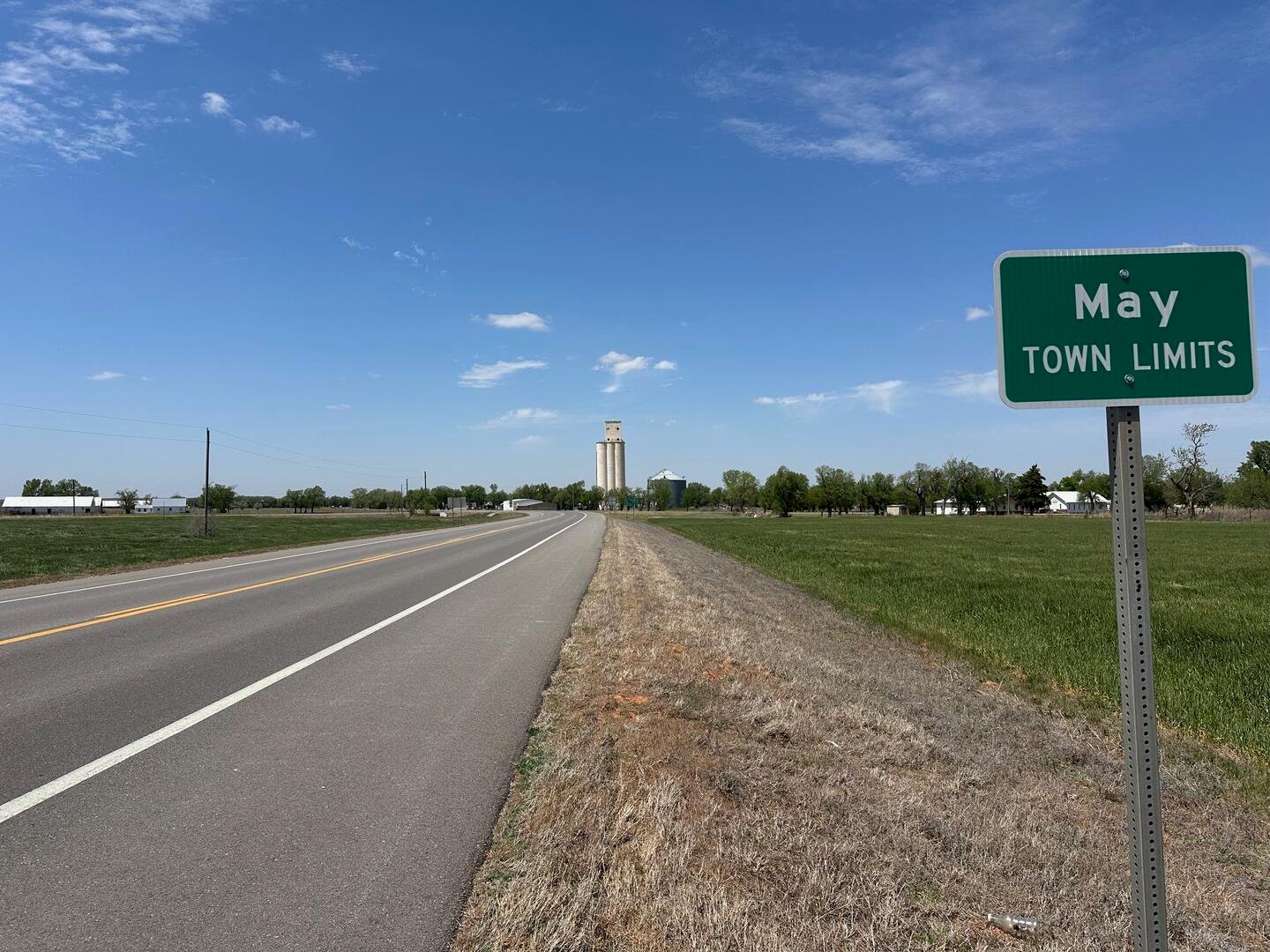
Northeast Oklahoma doesn’t announce itself. It unfolds—one ridge, one pasture, one weathered main street at a time—until you realize you’ve driven hours without the landscape repeating. Here, the distances aren’t measured in miles but in how far the next neighbor’s porch light is from your own.
The towns scattered through this corner of the state have survived on a mix of stubbornness and adaptation. Some grew along the rails, others by the rivers, and a few never had a reason to grow at all. What they share is a pace dictated by the land: the turn of a combine, the flood of a spring creek, the long shadows that reach across two-lane roads before supper.
They’re places where a name still matters, where an extra minute at the café counter is part of the day’s accounting. Main streets are short but steady, the kind where brick facades shelter feed stores and post offices, and where a single painted bench might be the busiest seat in town.
This list counts down 25 of the most secluded spots in Northeast Oklahoma—places buffered by pasture, water, and habit. They’re not hidden so much as overlooked, and in that oversight lies their quiet advantage.
25. Wann – Prairie Hamlet on the Kansas Line
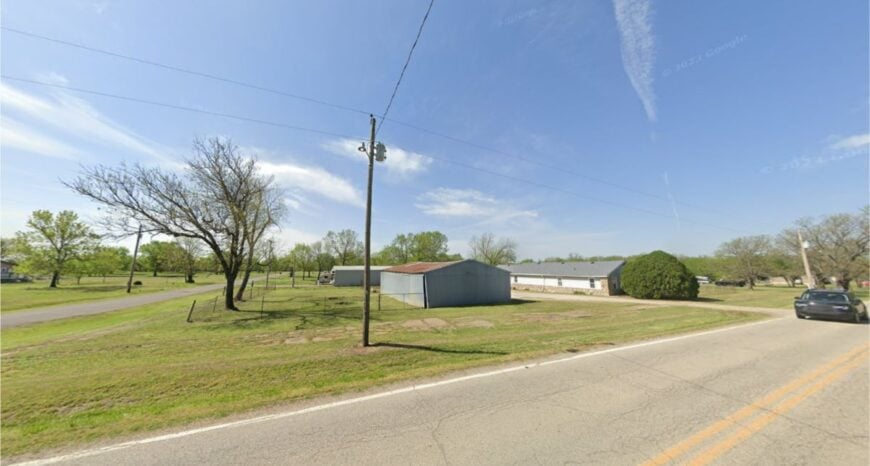
Wann sits so close to the Kansas border that radio stations swap states with the wind, yet the town itself hardly stirs. Its seclusion comes from long section roads and big ranch parcels that keep neighbors comfortably distant.
The vibe is low-key and country-quiet: porch gliders, grain bins, and meadowlarks stitching the silence from fencepost to fencepost. Walk the sleepy grid for elevator-and-water-tower photos, scout pronghorn and wild turkey along pasture edges, or time an evening drive to catch thunderheads shouldering up over the tallgrass.
In the fall, you’ll hear combines before you see their lights; in the winter, you’ll hear only the wind. Most folks make a living from cattle and crops or commute to jobs over the county line. Wann is the sort of place that proves a horizon can be company.
Where is Wann?

Tucked in far northern Nowata County, Wann is about 20 miles north of Nowata and a short hop from the Kansas state line. You get there via US-169, then a quiet jog on county blacktop that trades speed for sky.
With interstates far away and shelterbelts guarding the edges, highway hum never finds it. It’s close enough to reach before lunch, but distant enough that the afternoon feels borrowed.
24. Lenapah – Railside Pause with Big-Sky Nights
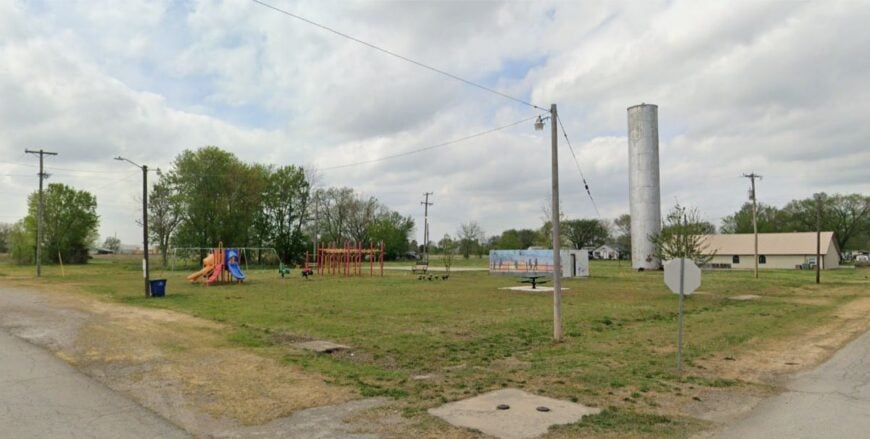
Lenapah keeps a steady rhythm beside the rails, a trim little town where porch lights glow and the stars feel close. It stays secluded thanks to wide swaths of pasture and the long gaps between service stations and stoplights.
The mood is porch-friendly and practical: tidy lawns, a café that knows your order, and grain trucks that come and go with the seasons. Stroll past century-old storefronts, birdwatch along creek bottoms, cast a line in nearby farm ponds (with permission), or chase golden-hour photos on gravel spurs.
Work here follows cattle, hay, and small-shop trades. When the freight horn fades, the silence rushes back in like a tide. Lenapah turns “nothing happening” into a compliment.
Where is Lenapah?

Set in northern Nowata County, Lenapah sits along US-169 roughly 14 miles north of Nowata and 25 miles south of Coffeyville, Kansas. The final miles are straight, open, and honest about the distance.
Trees and low ridges keep sightlines simple and soundscapes soft. It’s an easy drive that ends in a gentler tempo.
23. Delaware – Old Main Street on the Prairie Edge
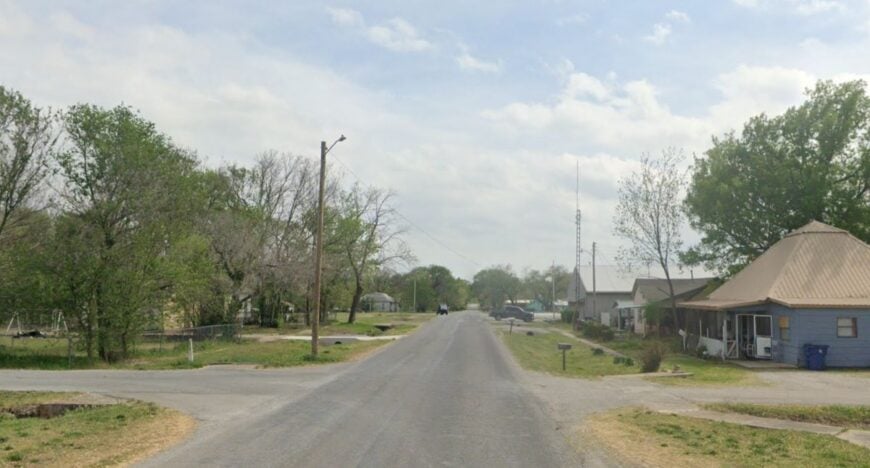
Delaware wears its history lightly—brick fronts, an old depot, and quiet streets where the wind does most of the talking. Seclusion lingers because the town sits between bigger dots on the map, wrapped in pasture where headlights are rare after dark.
The vibe is neighborly and unhurried: garden rows, mailbox flags, and dogs asleep under pickups. Pop into a small museum or antique nook if it’s open, wander out to the Verdigris bottoms for birds, or take a sunset loop on the section roads to watch storm cells bloom.
Agriculture underpins the week, with school events and church suppers setting the calendar. Nights answer only to crickets and sprinklers. Delaware makes stillness feel intentional.
Where is Delaware?
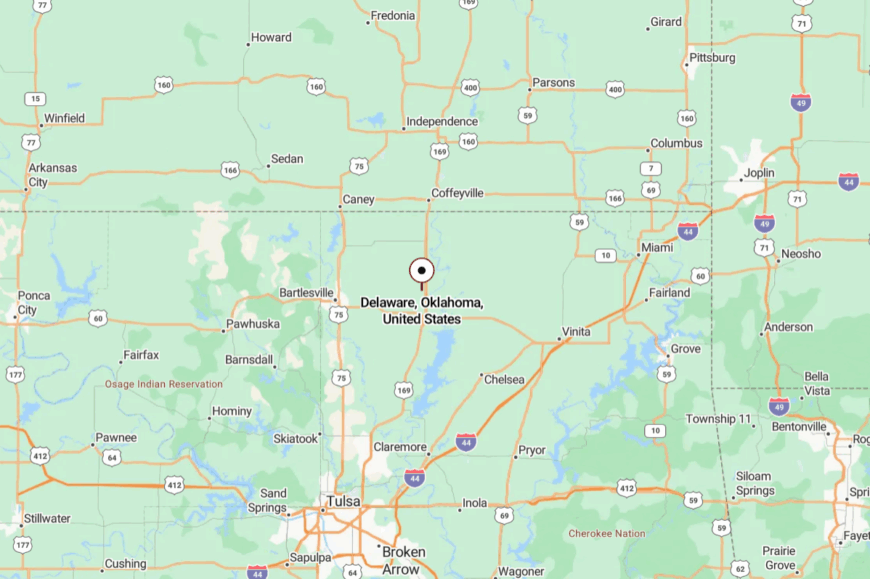
You’ll find Delaware in northwest Nowata County, about 10 miles northwest of Nowata on US-169. Turn off the highway and traffic thins to a local pace.
Low hills and windbreaks hush the world a notch or two. It’s close enough for a quick errand, far enough for a full exhale.
22. Copan – Lake-Country Quiet above the Caney
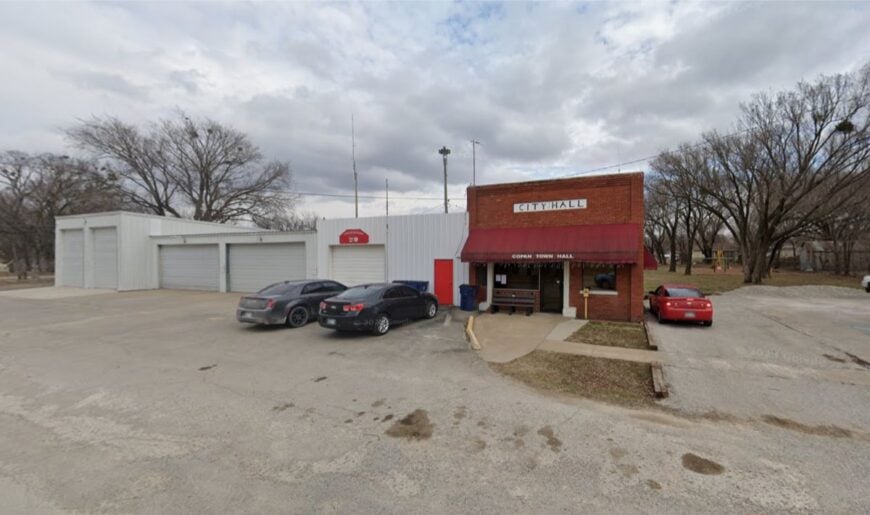
Copan is a little hinge between prairie and water, a town that moves at the speed of fishing stories and fence repairs. It’s secluded by the simple geometry of distance: far from interstates, buffered by pastures, and backed by the open water of Copan Lake.
The vibe is easy and outdoorsy—coolers on porches, kayaks in truck beds, and herons ghosting the shoreline at dusk. Fish the coves at daybreak, walk the dam for long views, photograph the elevator against a clean horizon, or poke into Bartlesville’s museums and be back by dark.
Work leans on agriculture, lake-season services, and jobs down the road. After sundown, the sky is big enough to make wishes feel reasonable. Copan is where weekends learn to breathe.
Where is Copan?

Northern Washington County claims Copan, about 12 miles north of Bartlesville along US-75 and minutes from Copan Lake. The last bit of driving trades city lanes for two-lane quiet.
Open water and rangeland keep the edges uncluttered and the nights dark. It’s easy to spot—and easier to forget your phone.
21. Ochelata – Back-Road Gateway to the Tallgrass
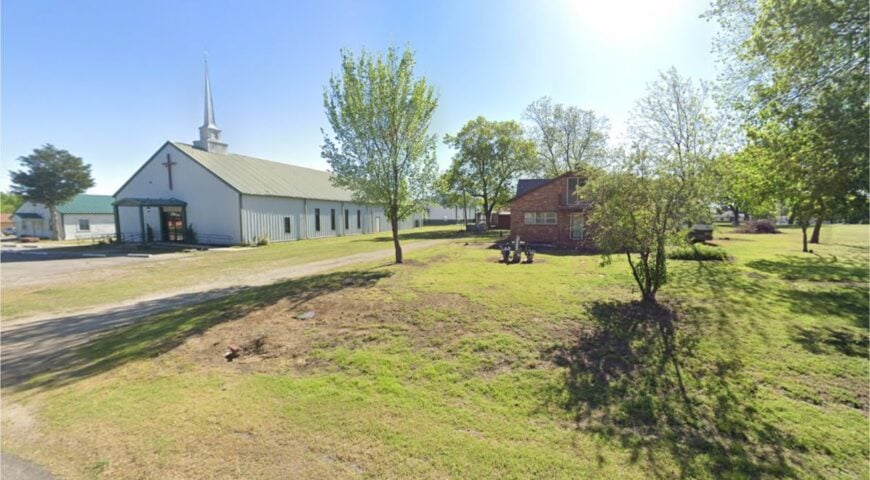
Ochelata sits just off the main flow, a small town with tidy blocks and a habit of pointing visitors toward the country. Its seclusion comes from living a mile or two sideways from US-75, where traffic slides past without noticing the turn.
The feel is homey and work-worn: flags on porches, tractors easing down side streets, and screen doors that know every hand in town. Browse a tiny diner or market, detour to nearby Woolaroc’s prairie and bison herds, drive gravel loops for meadowlarks, or bring a lawn chair for meteor-watching.
Day jobs mix farm, shop, and museum-country hospitality. Evenings smell like cut grass and lilac. Ochelata is that welcome pause before the prairie opens up.
Where is Ochelata?
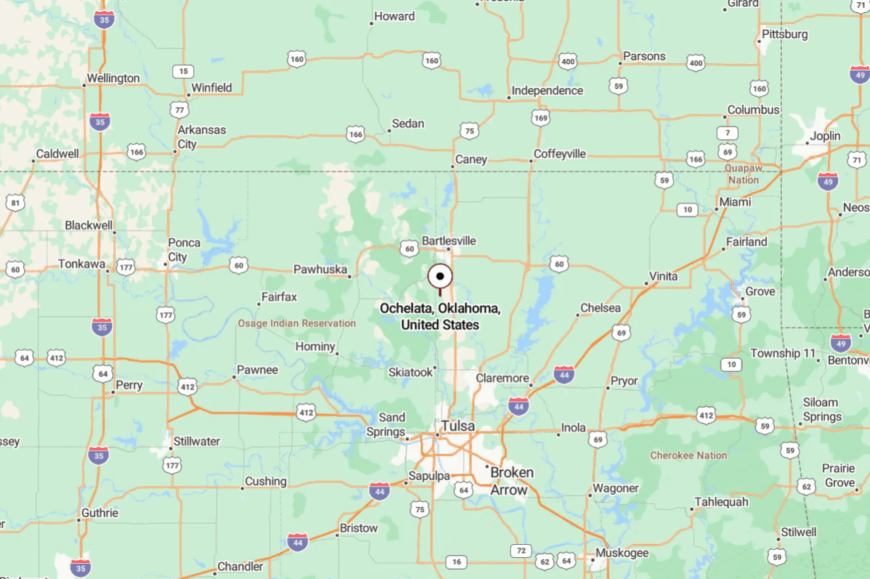
In central Washington County, Ochelata lies roughly 8 miles south of Bartlesville, a short jog west of US-75. County roads take the edge off speed and sound alike.
Low rises and windbreaks keep the town tucked from highway fuss. It’s close to everything and still feels set apart.
20. Ramona – One-Street Grace between Creek and Grass
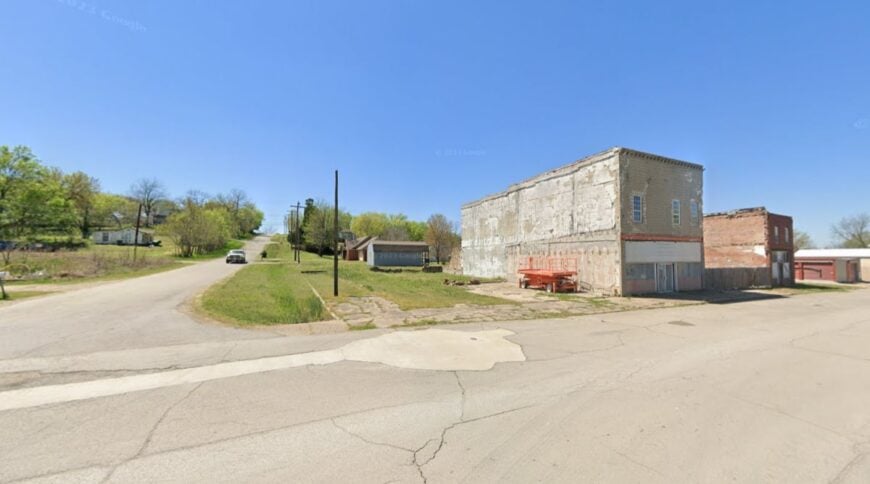
Ramona moves softly along the prairie, a one-main-street town with big sky and small talk done right. Seclusion holds because the nearest bustle is just far enough away to stay out of earshot, and because the land itself prefers quiet.
The vibe is neighborly and old-fashioned: pickup waves, lemonade on porches, and sprinklers hissing at dusk. Walk the simple grid for brickwork and vintage signage, birdwatch along fencerows, or cruise a dirt loop to watch clouds build over the fields.
Folks work in agriculture, small trades, or commute up to Bartlesville and back with the sun. Night comes on like a slow song. Ramona proves there’s elegance in an unhurried day.
Where is Ramona?
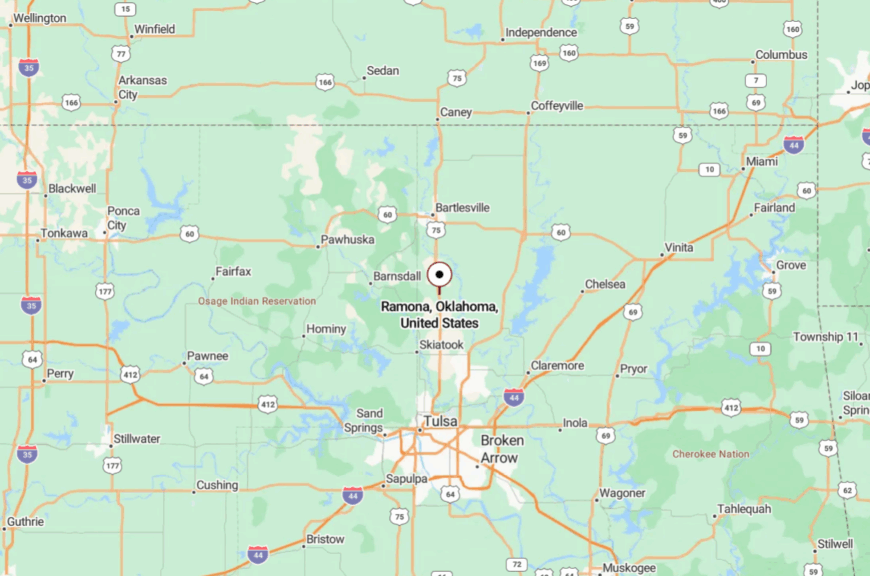
Southern Washington County holds Ramona along US-75, about 25 miles north of Tulsa and 12 miles south of Bartlesville.
You slip off the highway, and the volume drops instantly. Pasture and shelterbelts frame the town like soft parentheses. It’s near the road yet a world removed.
19. Proctor – River Bends and Oak-Shade Lanes
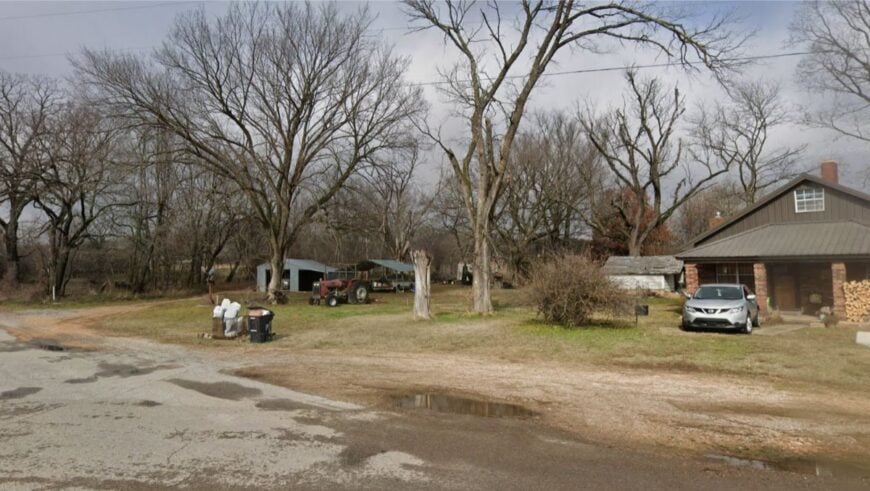
Proctor hides in the folds of the Ozark foothills, where roads curve to match the Illinois River’s easy grammar. It feels secluded because the hollows are deep, the ridgelines high, and there’s no reason to pass through unless you mean to.
The vibe is rustic and river-wise—kayaks on racks, strings of trout flies drying by the door, and woodsmoke curling from chimneys in cool months. Float a gentle stretch of the Illinois, hunt spring warblers in oak-hickory woods, picnic at low-water crossings, or scout old cemeteries tucked into the trees.
Work here is ranch, garden, and a drive to Tahlequah when errands demand it. By evening, crickets outnumber cars a hundred to one. Proctor makes the river feel like a neighbor.
Where is Proctor?
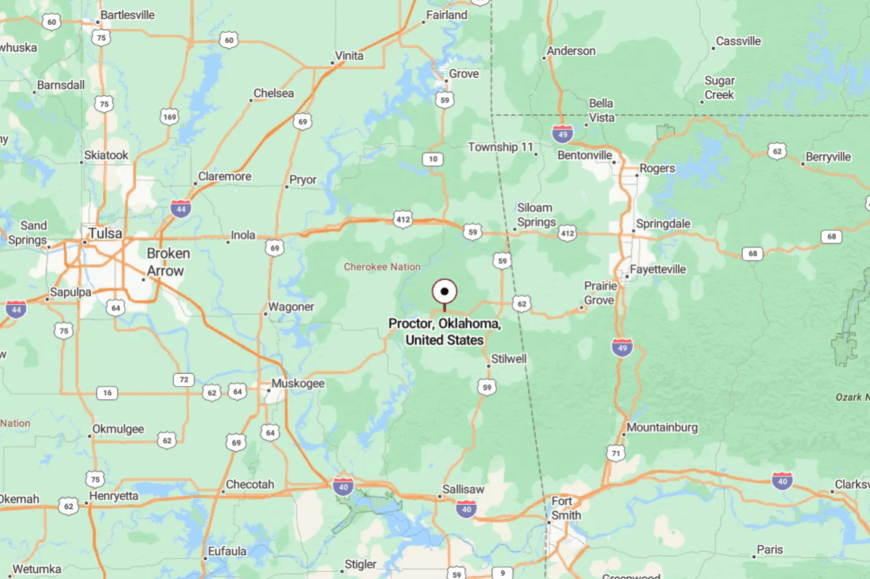
Western Adair County claims Proctor along OK-100, about 15 miles west of Stilwell and 14 miles east of Tahlequah. The approach is all curves and canopy, a two-lane highway that insists you slow down.
High ridges block city glow and cell bars alike in places. It’s close to the water, far from the rush.
18. Bunch – Piney Quiet under the Ridge
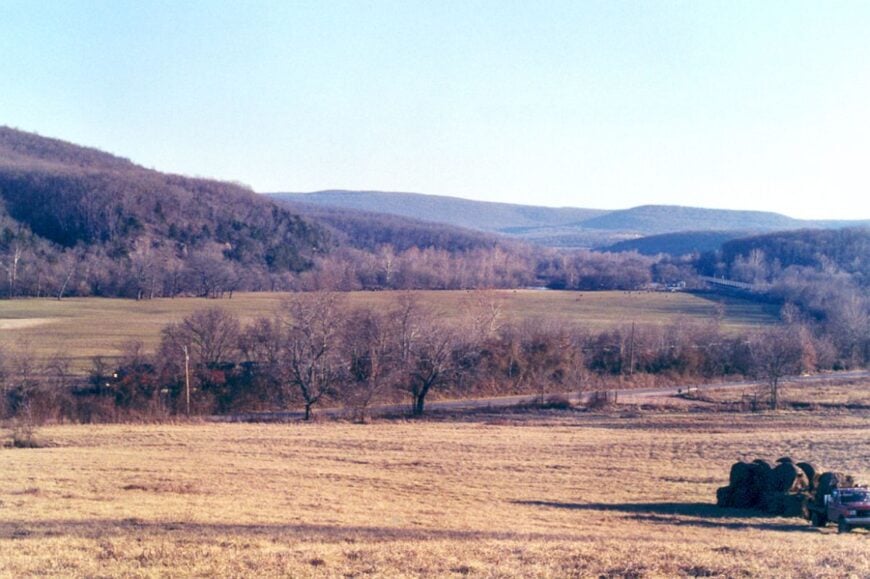
Bunch is the sort of crossroads where the woods do most of the talking and the ridge keeps outside noise on the other side. Seclusion comes from distance and trees—miles of hills, spring-fed creeks, and gravel lanes that feel content to be gravel.
The vibe is plainspoken and wood-smoked: stacked firewood, hounds napping in shade, and gardens that feed more than one family. Walk to a low bridge for kingfisher flashes, hike logging spurs for mushrooms after rain, cast for sunfish in clear pools, or drive out for dusk views where the hills go lavender.
Livelihoods lean on ranching, timber, and a few commuters. Night skies show every constellation that will hold still. Bunch is proof that quiet can thrive.
Where is Bunch?
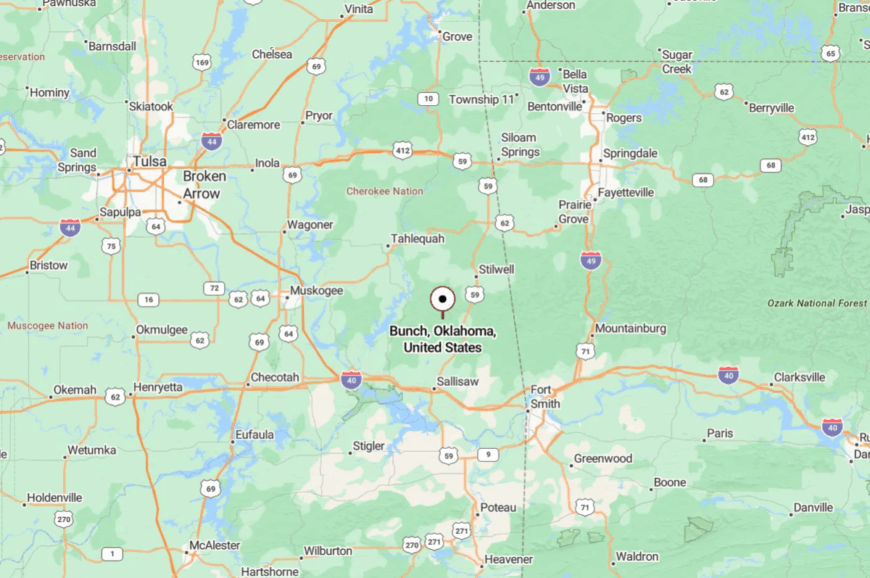
Central Adair County holds Bunch along OK-59, roughly 10 miles south of Stilwell. The highway narrows to a local rhythm, then gives way to backroads under a heavy canopy.
The folds of the land hide it until the last minute. It feels like a pocket the world forgot to empty.
17. Welling – River Porches Near a Big Blue Lake

Welling spreads out among trees and water, a scattering of homes where porches face the breeze off the river. Its seclusion comes from the long sweep of forest and the absence of any real hurry between Tahlequah and the lake.
The vibe is restful and boat-casual: kayaks leaning on fences, hammocks between oaks, and coolers ready for a swim day. Float a calm reach of the Illinois River, explore lakeside coves at Tenkiller, hike shady loops at nearby parks, or sip coffee while mist lifts off the water.
People work in town or in small trades, but evenings belong to cicadas. When the sun drops, the trees seem to breathe. Welling is a porch-swing invitation.
Where is Welling?
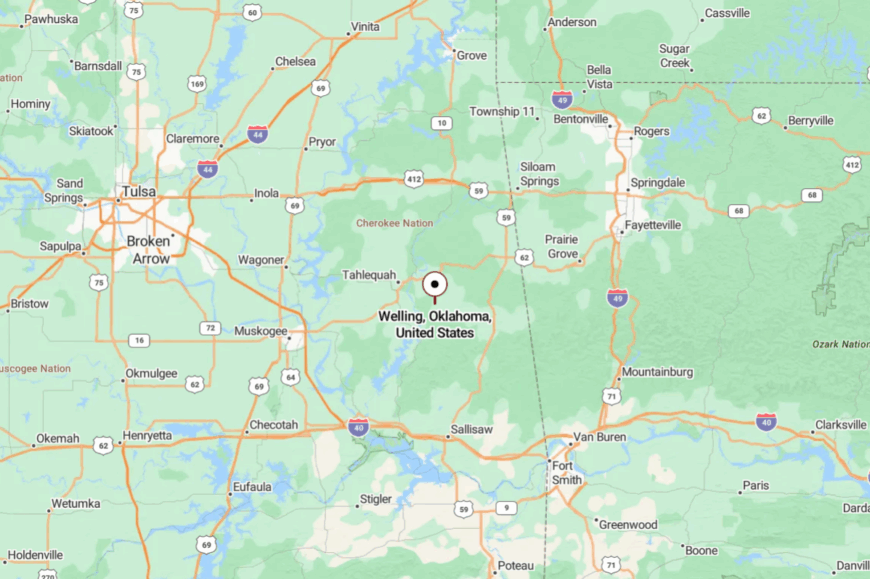
Southeastern Cherokee County holds Welling along OK-82, about 9 miles south of Tahlequah and just north of Lake Tenkiller. The approach trades storefronts for canopy and river bends.
Forest buffers pull down the volume and the speed. It’s near good water, yet far from crowds.
16. Lost City – Hillside Homesteads under a Famous Sky
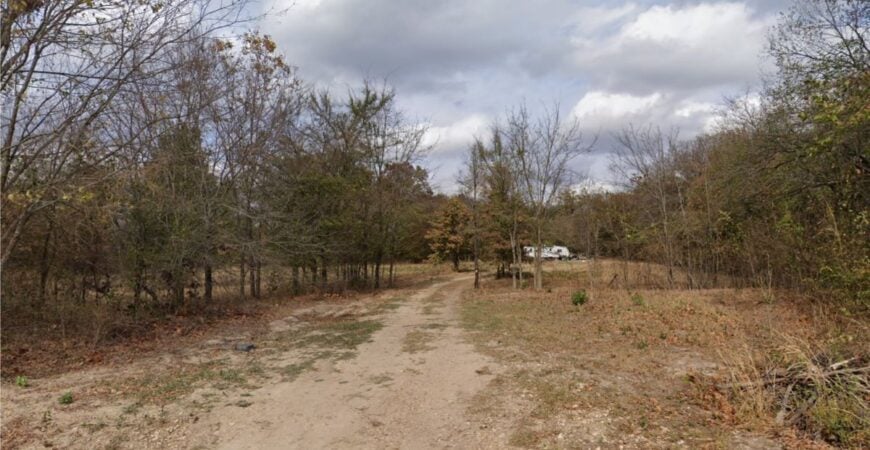
Lost City is a scatter of hillside homesteads and pasture lanes, known to sky-watchers for a meteor that once announced itself across these hills. It stays secluded because the roads are winding, the parcels large, and the nearest town lights a distant glow on clear nights.
The feel is quietly independent: garden beds, mended fences, and a mailbox list you could memorize in an afternoon. Walk ridge roads for big-sky views, listen for whip-poor-wills at dusk, fish a neighbor’s pond (ask first), or photograph hay bales stacked like sculpture.
Ranch chores and school runs link the week together. When the wind lies down, you can hear a gate latch a pasture away. Lost City gives night back to the stars.
Where is Lost City?
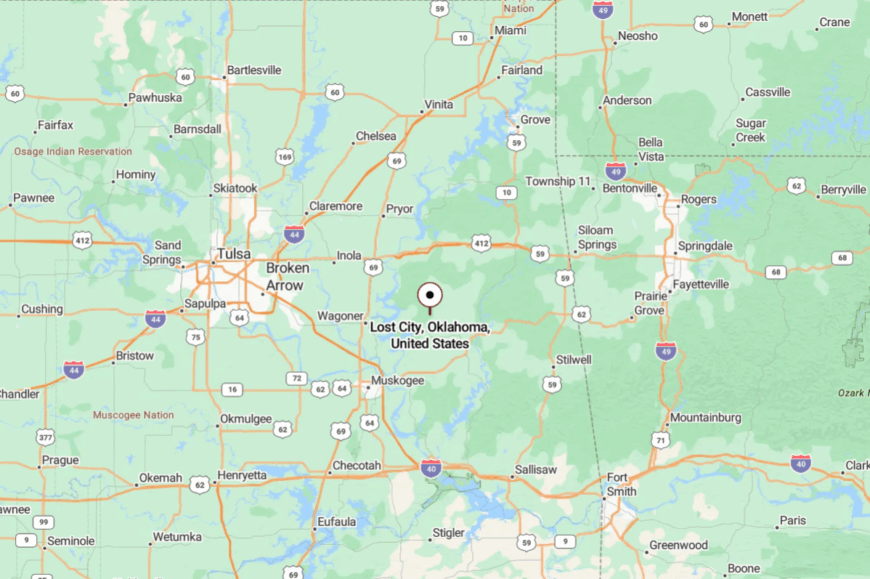
North-central Cherokee County holds Lost City, roughly between Peggs and Hulbert and about 15 miles northwest of Tahlequah. You reach it on county roads that swap pavement for gravel and back again.
Low ridges and timber make a natural curtain against noise and glare. It’s not far on the map, but it feels a step outside time.
15. Briggs – River Meanders and Morning Fog
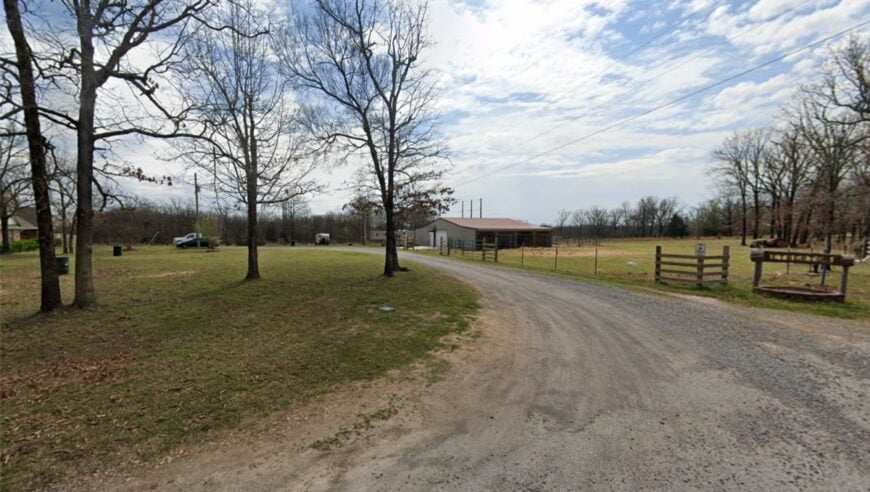
Briggs keeps to the river’s tempo, a modest community where morning fog drifts across pastures and disappears into woods. Its seclusion is courtesy of the Illinois River corridor—steep banks, tight bends, and side roads that agree to stay small.
The vibe is barefoot and bird-song bright: canoes on trailers, stringers on the porch rail, and garden hoses hissing in the heat. Paddle a lazy reach, cast for smallmouth from gravel bars, picnic under sycamores, or drive ridge loops for dusk views. Work mixes ranch chores, river-season jobs, and commutes to Tahlequah.
Nights arrive with whip-poor-wills and a dark sky clean enough to keep you outside. Briggs is what quiet sounds like when it learns a melody.
Where is Briggs?
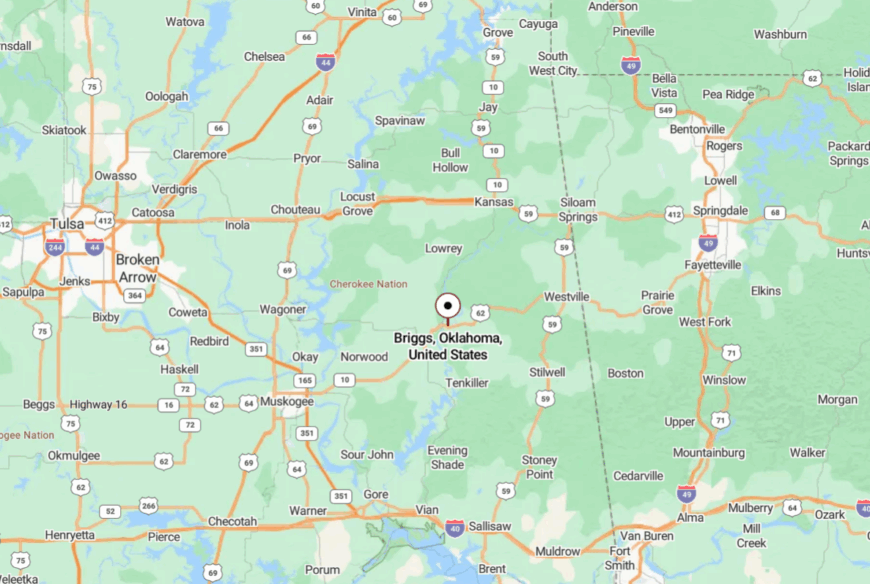
Briggs sits in east-central Cherokee County along OK-10, about 8 miles east of Tahlequah.
The last miles follow the river’s curves, easing any urge to rush. Trees and bluffs make a green wall against highway clatter. It’s close to town, far to the ear.
14. Eucha – High-Country Porches above a Quiet Lake
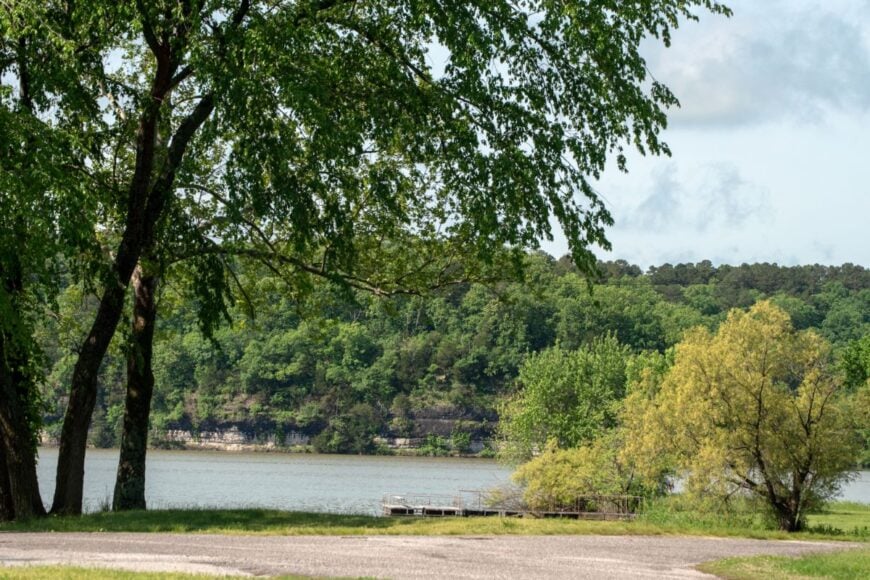
Eucha climbs the hills above its namesake lake, a scattering of porches that trade gossip with the wind. Seclusion sticks because the roads in are twisty two-lanes and the lots are big, so neighbors stay neighbors at a distance.
The vibe is lake-casual and country-proud: jon boats on trailers, quilts on clotheslines, and dogs that nap wherever the shade lands. Fish dawn coves on Lake Eucha, drive to scenic pullouts for long views, poke around roadside stalls for honey and pecans, or follow a gravel spur until the trees part for a sunset.
Work mixes ranch chores and lake-season service with a few commutes to Jay. Night falls, and crickets take the mic. Eucha feels like a front-row seat to the sky.
Where is Eucha?

Northeastern Delaware County holds Eucha, about 8 miles south of Jay and west of the Lake Eucha shoreline. Access comes on county roads and OK-10/OK-28 spurs that trade speed for scenery.
Hills and timber keep it sheltered from busier lake towns. It’s near the water but away from the waves.
13. Bull Hollow – Hidden Draws in the Hills
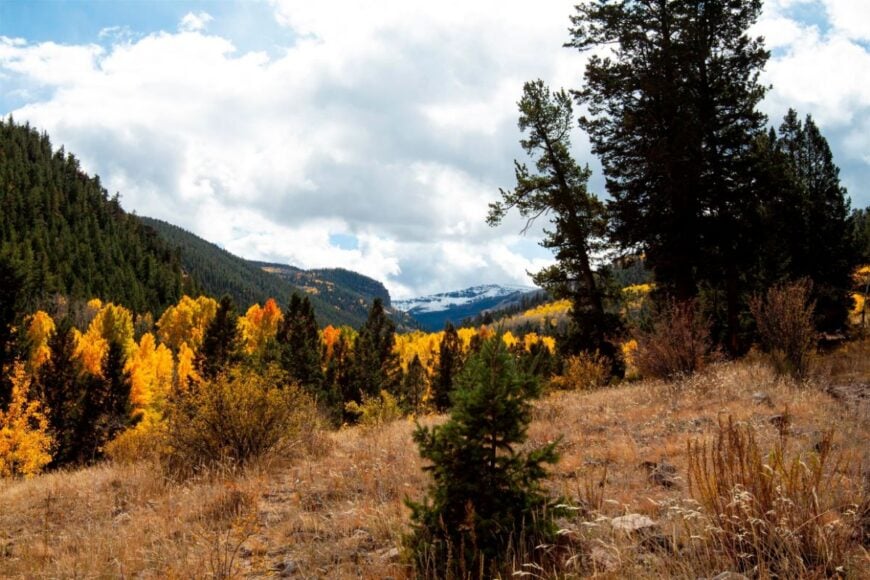
Bull Hollow is little more than hills, hollows, and homes tucked so well into the trees you’ll miss them unless the light is right. Seclusion is the whole idea: steep gravel lanes, big tracts of oak-hickory woods, and a habit of pointing visitors to the nearest shade rather than the nearest store.
The vibe is rustic and private—woodpiles stacked high, tin roofs pinging in summer rain, and owls that claim the night. Hike old logging cuts for mushrooms after a storm, watch deer step from the brush at dusk, photograph switchbacks where the road meets sky, or listen to spring creeks braid the silence.
Livelihoods lean rural and independent. When the wind shifts, you can hear an axe ring two hollows over. Bull Hollow keeps the map honest: there’s a lot of green between lines.
Where is Bull Hollow?
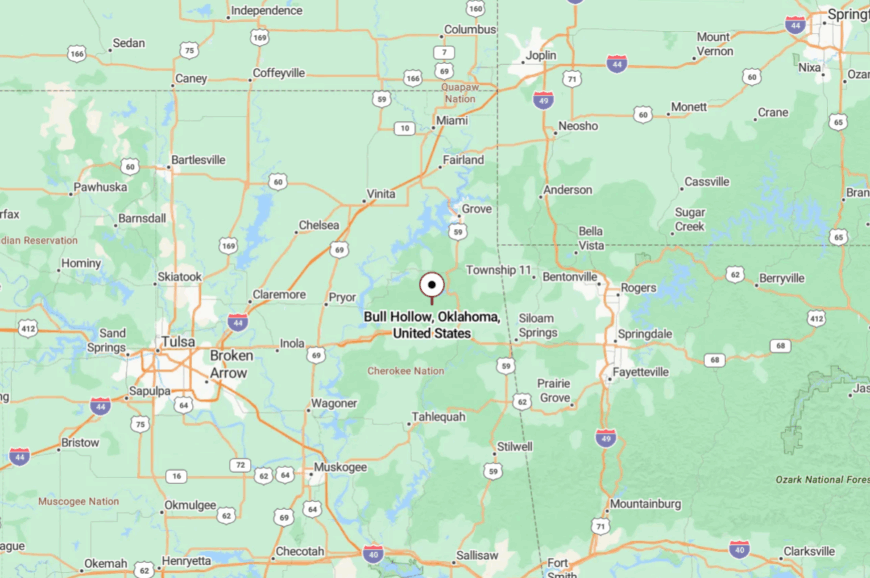
You’ll find it in central Delaware County between Oaks and Kenwood, reachable by curving county roads off OK-82/OK-412A. The last miles run through tight canopy and short sightlines.
Elevation and timber hush both traffic and time. It’s a place you arrive at thoughtfully.
12. Spavinaw – Stone-Wall Streets beside a Blue Reservoir
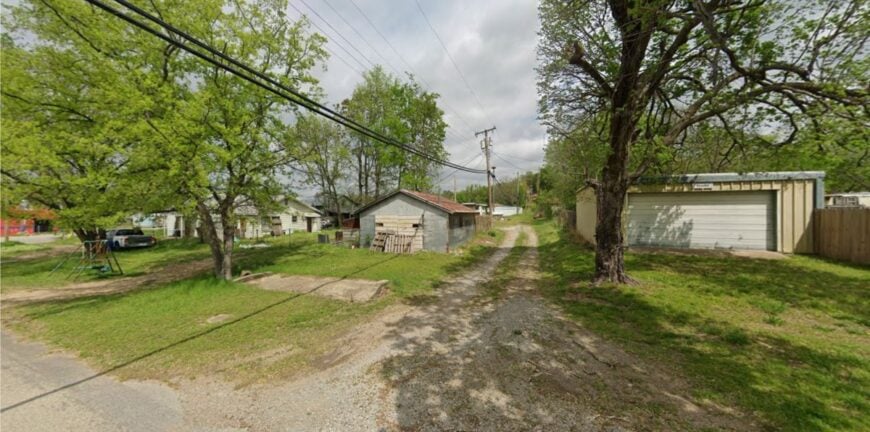
Spavinaw gathers under tall sycamores where a stone-walled creek slips toward the lake, and the days drift as slowly as the water. It’s secluded because hills fold tight around town, and the approach roads convince you to downshift to local speed.
The vibe is vintage and creek-cooled: limestone facades, porch fans, and children fishing under low bridges. Cast for bass in the coves, stroll shaded streets to the spillway, picnic in pocket parks, or birdwatch where the creek widens into a lake.
Small shops and lake-season visitors give the economy a gentle pulse. By evening, the only rush is the spill of water. Spavinaw pairs cool stone with quiet air.
Where is Spavinaw?

Eastern Mayes County holds Spavinaw along OK-20/OK-82, about 20 miles south of Jay and 18 miles east of Pryor. The route winds through hills and timber before the lake appears.
Ridges and water together muffle outside noise. It’s near the blue, and blissfully off the beaten path.
11. Strang – Little Grid above Lake Hudson’s Quiet Coves
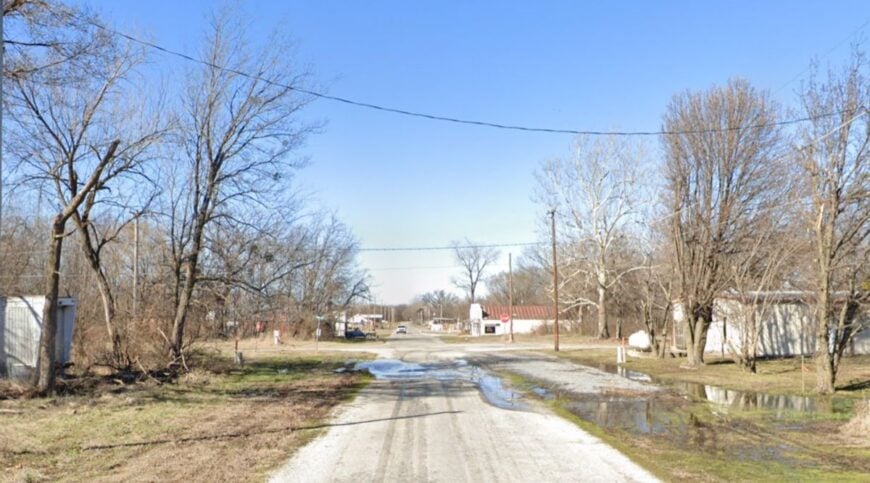
Strang is a postcard-small town tucked on a rise above Lake Hudson, its streets so still you can hear sprinklers ticking half a block away. Seclusion comes from being a few miles off the main highway with no reason for through-traffic to bother it, and from the way the lake’s inlets keep development scattered.
The vibe is friendly and matter-of-fact: a few porches, a few trucks, and a lot of sky. Scout backroads to quiet boat ramps, fish for crappie beneath shady points, photograph vintage signs on brick, or watch storms drag their skirts across the water.
Work revolves around farms, lake-season gigs, and commutes toward Pryor or Salina. After dark, the lake becomes a mirror for stars. Strang is the hush between shorelines.
Where is Strang?

Northern Mayes County holds Strang a few miles north of OK-82 and west of Lake Hudson’s middle reaches. You reach it on two-lane country roads that climb and dip through timber and pasture.
With bigger towns set back and the lake wrapping the edges, the place stays naturally quiet. It’s close enough to launch a boat, yet far enough to forget the launch ramp line.
10. Teresita: Off the Map and Into Tranquility

Teresita is a tiny, unincorporated community that feels like a world apart from the hustle and bustle. With a population that’s so small it’s not even listed in census data, I’ve found that it’s the perfect place to disconnect.
There aren’t any major industries here, just a few local farms and ranches that dot the landscape. The real draw is the surrounding nature: rolling hills, dense woodlands, and the kind of quiet you can only find far from city lights.
Teresita’s seclusion is its greatest asset, offering a peaceful environment that’s hard to come by these days.
Where is Teresita?

Located in Cherokee County, Teresita sits nestled in the verdant hills of Northeast Oklahoma. It’s not on most maps, which adds to its hidden charm. The town is accessed via winding country roads that meander through forests and pastures.
Getting there requires a bit of effort—there’s no direct highway access—but I think that’s part of what keeps it so secluded. For those willing to make the trip, Teresita offers a true escape into tranquility.
9. Rose: Hidden Away in the Verdant Hills

Rose is another unincorporated community that exudes rural charm. With a population of around 300 people, it’s a place where everyone seems to know each other. There aren’t any big industries here, just small family farms and a few local businesses.
The area is rich in natural beauty, with plenty of opportunities for hiking, bird watching, and simply enjoying the countryside. What makes Rose so secluded is its abundance of undeveloped land and its location away from major roads and cities.
Where is Rose?

Rose is situated in Mayes County, tucked away in the lush landscapes of Northeast Oklahoma. It’s a bit off the beaten path, located along U.S. Route 412 but without much in the way of commercial development.
This remoteness means that even though it’s accessible by car, it remains a quiet haven away from urban life. I’ve always appreciated the peaceful drives through the rolling hills to get there, as the journey itself feels like a step back in time.
8. Peggs: A Small Community with Big Seclusion

Peggs is a small town with a population of just over 800 people. It has a close-knit community feel, and the main industries are centered around agriculture and small local businesses. There’s not a lot of tourist activity here, which I think adds to its appeal.
Surrounding Peggs are expansive natural areas perfect for outdoor enthusiasts who enjoy fishing, hiking, and exploring without crowds. The low population density and surrounding natural features provide residents with a peaceful environment that’s hard to find elsewhere.
Where is Peggs?

Located in Cherokee County, Peggs is nestled in the northeastern part of Oklahoma. It’s accessible via State Highway 82 but lacks the heavy traffic of larger towns. The seclusion comes from its rural setting and the miles of farmland and forests that separate it from bigger cities.
To get there, you’ll drive through scenic countryside that emphasizes just how pleasantly removed Peggs is from urban sprawl.
7. Leach: Quiet Countryside Living

Leach is a small unincorporated community with a population hovering around 200 people. The area is dominated by expansive farmlands and open spaces. There’s a simplicity to life here that I find refreshing, with the primary activities revolving around farming and enjoying the outdoors.
Leach’s distance from urban centers and low population make it an ideal spot for those seeking a tranquil rural lifestyle away from the noise and congestion of city life.
Where is Leach?

Leach is situated in northeastern Oklahoma’s Delaware County. It’s off U.S. Route 412, tucked away amid rolling hills and fertile fields.
The town’s seclusion is due in part to its geographical location, nestled between larger towns without being directly connected to any major thoroughfares. Getting to Leach involves a scenic drive through the countryside, reinforcing the sense of leaving the busy world behind.
6. Twin Oaks: Serenity Under the Canopy

Twin Oaks is a community that lives up to its name, surrounded by lush woodlands and dotted with towering oak trees. The population is small, with just over 200 residents calling it home.
There are few businesses here, which contributes to the minimal development and quiet atmosphere. I’ve always thought Twin Oaks is ideal for those desiring solitude and a deep connection with nature.
The dense forests provide a canopy that seems to shelter the town from the outside world, enhancing its secluded feel.
Where is Twin Oaks?

Located in Delaware County, Twin Oaks is nestled in the northeastern part of Oklahoma. The town is accessed primarily via local roads, as it isn’t situated on any major highways. This lack of direct access contributes to its seclusion, making it a peaceful retreat.
I find that the journey to Twin Oaks is part of the experience, as you wind through forested areas that gradually lead you to this hidden gem.
5. Oaks: A Tiny Town Surrounded by Rolling Hills

With a population of approximately 300 people, Oaks offers an intimate community setting. The town is surrounded by picturesque landscapes of rolling hills and open fields. There aren’t any major industries here; life moves at a slower pace centered around family and community events.
The isolated location and small population contribute to a peacefulness that’s perfect for anyone looking to escape the noise of larger towns. I’ve always enjoyed visiting Oaks for its serene environment and friendly locals.
Where is Oaks?

Oaks is located in Delaware County, just off U.S. Route 412. Despite its proximity to this highway, the town remains quiet and relatively untouched by heavy traffic. The surrounding hills act as a natural barrier, enhancing the feeling of seclusion.
Getting to Oaks is straightforward, but once you’re there, it feels like you’re miles away from the hustle and bustle, which is one of the things I love about it.
4. Kenwood: A Remote Community Steeped in Cherokee Culture

Kenwood is a small community with deep Cherokee roots, and a population of around 1,200 people. The area is rich in cultural history, and you’ll find that the residents take pride in their heritage. There are no major industries aside from local farming and artisan crafts.
What makes Kenwood secluded is its rural charm and low housing density, allowing for plenty of space between neighbors. The tight-knit community and cultural richness provide a unique atmosphere that I find both welcoming and peaceful.
Where is Kenwood?

Situated in Delaware and Mayes counties, Kenwood lies in the heart of Northeast Oklahoma. It’s off the beaten path, accessible via county roads rather than major highways. This remote location contributes to its seclusion, as it isn’t a place you stumble upon accidentally.
I think the journey to Kenwood offers a beautiful drive through the countryside, and once you arrive, you’re greeted by a community that feels both isolated and intimately connected.
3. Flint Ridge: Secluded Living in the Ozark Foothills

Flint Ridge is a gated community that offers large lots and an abundance of natural beauty. With a population of about 600 residents, it’s a place where privacy is valued.
The community is surrounded by the Ozark foothills, providing stunning views and plenty of outdoor activities like hiking, fishing, and kayaking on the Illinois River. I’ve found that the secure environment and emphasis on quiet living make Flint Ridge a perfect spot for those seeking both seclusion and community amenities.
Where is Flint Ridge?

Located in Delaware County, Flint Ridge sits along the Illinois River in Northeast Oklahoma. Access to the community is controlled, which enhances its secluded feel.
The surrounding area is characterized by forests and hills, with limited development outside the community itself. Getting there involves a drive through scenic landscapes, and the gated entrance ensures that traffic is minimal, preserving the tranquility of the area.
2. Sycamore: A Peaceful Hamlet Amidst Nature

Sycamore is a small, unincorporated community with an emphasis on peaceful, rural living. The population is less than 100, making it one of the most sparsely populated areas I’ve visited. The town is surrounded by forests and farmland, providing ample opportunities for outdoor recreation and a strong connection with nature.
There are no significant industries here, and the lack of commercial development contributes to its tranquil atmosphere. Sycamore’s seclusion is perfect for those seeking privacy and a slower pace of life.
Where is Sycamore?

Sycamore is nestled in Delaware County, tucked away from major roads and urban centers. The town is reached via local roads that wind through the countryside, enhancing its remote feel.
Its location amidst dense forests and agricultural land adds to the sense of isolation. I appreciate how getting to Sycamore feels like a journey into a peaceful retreat, away from the demands of city living.
1. Zena: A Hidden Lakeside Community

Zena tops my list with its secluded location near Grand Lake and expansive acreages. The population is around 1,000 people, but the large land plots mean everyone has plenty of space.
The main activities revolve around lakeside living—fishing, boating, and enjoying the water without the crowds found at more popular tourist spots. There are no major industries in Zena, which helps maintain its quiet, residential feel. I love that despite being near a lake, it remains a peaceful enclave away from the hustle and bustle.
Where is Zena?

Zena is located in Delaware County on the western shores of Grand Lake. It’s off the main tourist paths, accessible via county roads that keep traffic to a minimum. The town’s seclusion comes from its sizeable properties and the surrounding natural landscapes.
Getting there involves a scenic drive through rolling hills and past the sparkling waters of the lake. For me, Zena offers the perfect blend of lakeside enjoyment and tranquil living.

